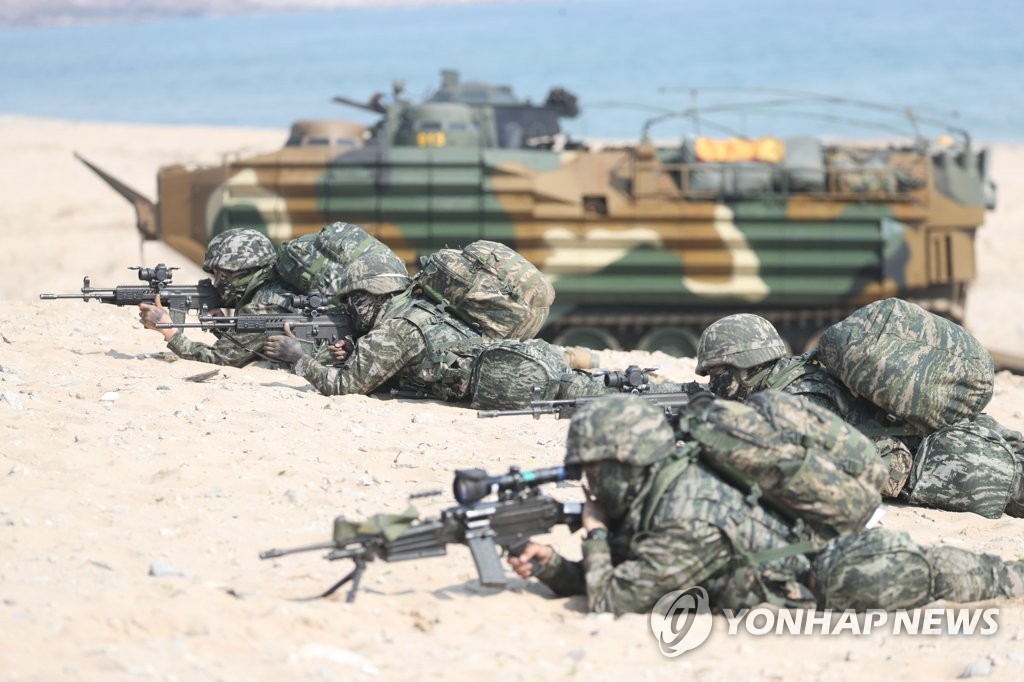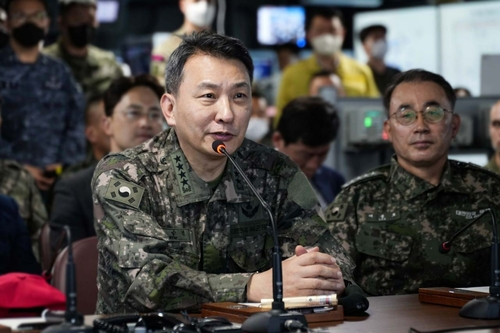- S. Korea unveils first graphic cigarette warnings
- US joins with South Korea, Japan in bid to deter North Korea
- LPGA golfer Chun In-gee finally back in action
- S. Korea won’t be top seed in final World Cup qualification round
- US men’s soccer misses 2nd straight Olympics
- US back on track in qualifying with 4-0 win over Guatemala
- High-intensity workout injuries spawn cottage industry
- CDC expands range of Zika mosquitoes into parts of Northeast
- Who knew? ‘The Walking Dead’ is helping families connect
- California Assembly OKs highest minimum wage in nation
S. Korea, U.S. stage ‘decisive action’ phase of major amphibious landing exercise
South Korea and the United States conducted major amphibious assault drills mobilizing their high-spirited forces, landing ships, stealth fighters and choppers under the rallying cry of “decisive action’ in a southern city on Wednesday.
The South’s Marine Corps revealed to the media part of the drills that proceeded in and around Pohang, 272 kilometers southeast of Seoul. They marked a highlight of the allies’ large-scale Ssangyong (double dragon) landing exercise, which runs through next Monday.
The drills came a day after North Korea released photos of its “Hwasan-31″ tactical nuclear warhead, adding to tensions caused by its earlier weapons tests, such as that of an “underwater nuclear attack drone” last week.
Joint Chiefs of Staff (JCS) Chairman Gen. Kim Seung-kyum oversaw the key phase of the Ssangyong exercise. South Korea-U.S. Combined Forces Command chief Gen. Paul LaCamera, Seoul’s Chief of Naval Operations Adm. Lee Jong-ho and other officials also observed it.

JCS Chairman Kim called on allied troops to be equipped with “capabilities and posture to cut and crumble the core of the enemy” through “swift and decisive” maneuvers in the event of an enemy invasion.
“The Navies and Marine Corps of the South and the United States are symbols of the alliance’s sturdy deterrence and punishment,” he was quoted as saying.

Participating troops emphasized their readiness posture, undeterred by North Korea’s continued saber-rattling.
“While ensuring our ‘decisive combat’ posture, the South Korean and U.S. Marine forces will further strengthen our combined defense posture capable of immediately punishing any enemy provocation,” Col. Yoo Chang-hoon, a Marine official, said.
Capt. Kevin Buss, communication strategy and operations officer of the U.S. 13th Marine Expeditionary Unit, said that the exercise is aimed at cementing allies’ capabilities for regional peace.
“Ssangyong is designed to build allied capacity, enhancing Indo-Pacific regional security through combined, integrated naval power,” he said.
Illustrating their “overwhelming” capabilities, the allies deployed division-level landing forces and some 30 vessels, including the amphibious assault ships, ROKS Dokdo and USS Makin Island. They also mobilized some 70 aircraft, such as F-35B radar-evading jets and AH-64 Apache attack helicopters, and around 50 amphibious assault vehicles.
The drills started with South Korean and U.S. combat aircraft staging a bombing campaign in an enemy area to clear operational obstacles and pave the way for the efficient amphibious maneuvers by allied forces, according to the Marine Corps.
Troops in full gear disembarked from ROKS Dokdo and USS Makin Island, and boarded amphibious vehicles and air-cushioned landing crafts to reach enemy coasts and carry out assault missions. Other troops entered enemy areas, using MUH-1 Marineon helicopters and MV-22 Osprey aircraft.
With the allies’ combat aircraft providing fire support overhead, the allied forces moved to a target coastal area and occupied a defense line there to allow for friendly forces to continue moving in and secure space for ground operations.
Earlier this month, the allies kicked off the first Ssangyong exercise in five years. It had not been held since its 2018 edition amid the preceding Moon Jae-in administration’s drive for inter-Korean rapprochement.











